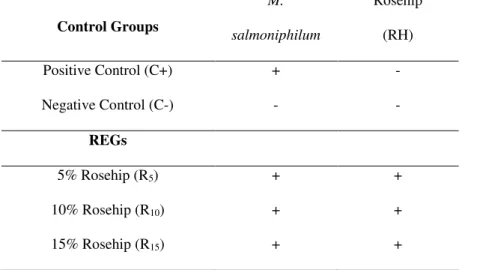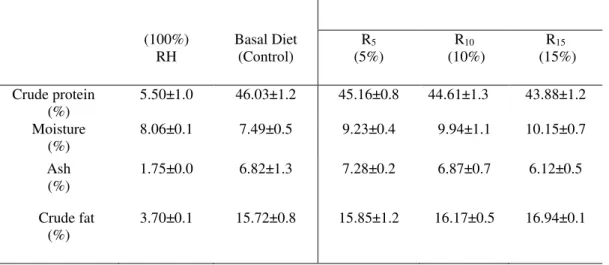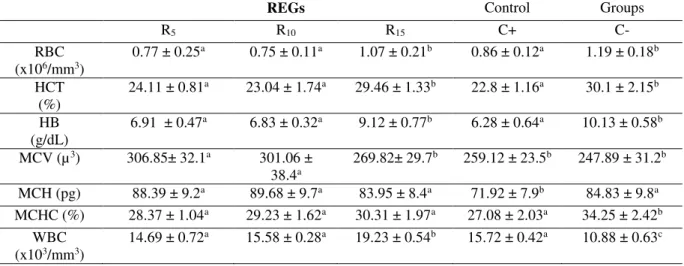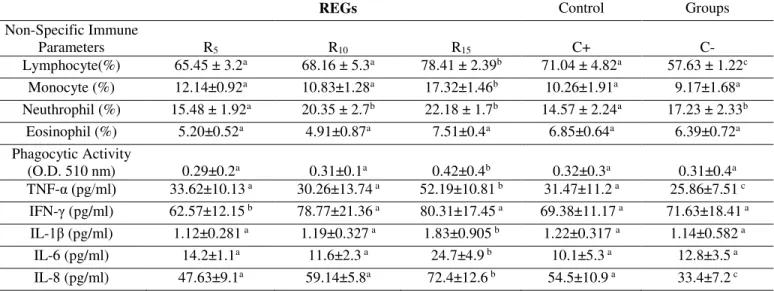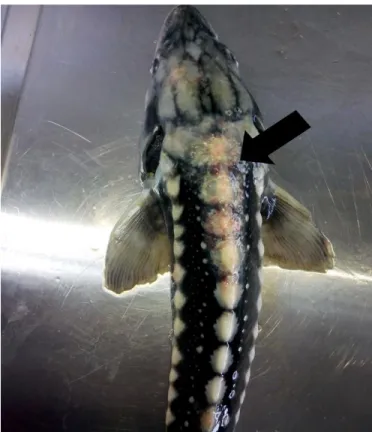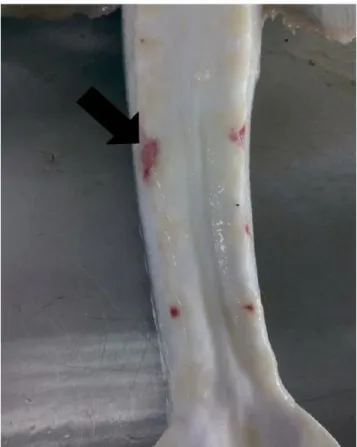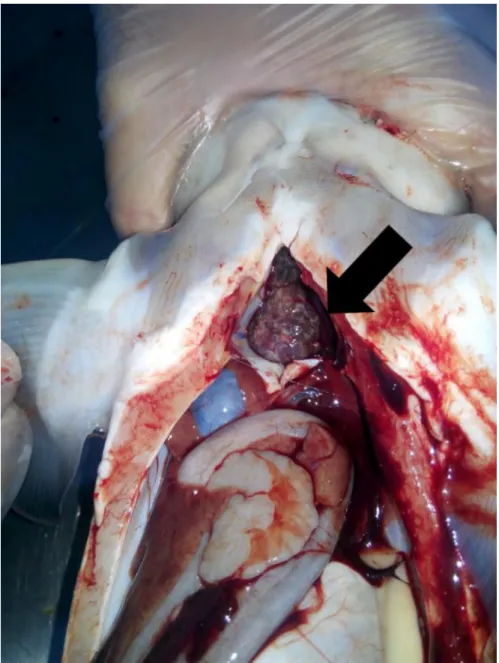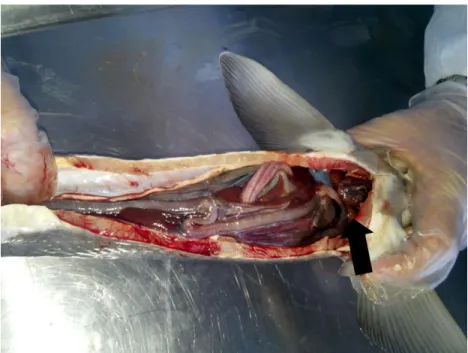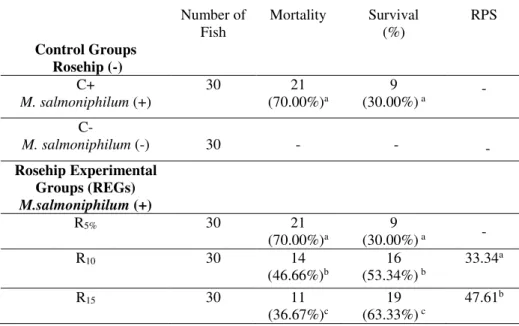ISSN 1678-4324 Online Edition
BIOLOGY AND TECHNOLOGY
A N I N T E R N A T I O N A L J O U R N A L
Some Hematological and Non-Specific Immune Responses of
Rosehip (
Rosa canina
) - Fed Russian Sturgeon (
Acipenser
gueldenstaedtii
Brandt & Ratzeburg, 1833) to
Mycobacterium
salmoniphilum
Selçuk Duman
1,Aysel
Şahan
2*,
1 Çukurova University, Fisheries Programme, Vocational School of Imamoglu Adana, Turkey. 2 Çukurova University, Fisheries Faculty, Department of Aquaculture, Adana, Turkey.
ABSTRACT
In the study, the immunostimulant effects of rosehip (Rosa canina) on the health indicator hematological and non-specific immune parameters of Mycobacterium salmoniphilum-infected sturgeon were investigated. The rosehip was applied in the ratios of R5 (5%), R10 (10%), and R15 (15%) in three repetitions. After a 35-day feeding period, the fish were infected with M. salmoniphilum and analyzed after day 7, when symptoms were observed at elevated levels. Erythrocyte, erythrocyte indices, hemoglobin, hematocrit, leukocyte levels and the non-specific immune parameters including lymphocyte, monocyte, eosinophil, neutrophil, cytokines, phagocytic activity levels were comparatively examined using positive and negative control groups. The evaluations revealed that the RBC, Hb, Hct and WBC counts in the R15 group were significantly higher than those of the C+ group. Moreover, depending on the level of the immune response of the fish, among the immune parameters, significant increases in the lymphocyte, monocyte, cytokine, and phagocytic activity levels were observed in the R15 group. The results showed that the hematological and immune response to M. salmoniphilum infection was stimulated significantly in the 15% rosehip-fed fish. Hence, the effective dose of rosehip in fish was determined to be 15% and rosehip is suggested as an alternative to currently recommended immunostimulants.
Keywords: Russian Sturgeon, Rosehip, Mycobacterium salmoniphilum, Hematological Parameters, Immunological
Parameters
INTRODUCTION
Sturgeon fish is well-adapted to the conditions in Turkey and thus, its production is carried out successfully in the country but their susceptibility to the pathogenic factors and their protection against the diseases are of great importance and therefore, require immediate attention1.
Fish mycobacteriosis is a chronic disease caused by Mycobacterium spp. It causes fish tuberculosis and is characterized by granulomas in various size in the tissues of fishes and directly targets spleen, kidney, and liver. Mycobacteriosis is a progressive, often lethal disease, affecting a wide range of fish species both farmed and wild and as a fish species of interest to the study, it prevalently afflicts sturgeon fish as well2.
Rosehip (Rosa canina L.) is used both in the pharmaceutical industry and, because of the essential oil content of its seeds, in the cosmetics industry as well as in vitamin C, proanthocyanin, and carotene production. As a micronutrient with immunostimulatory effects, rosehip is rich in vitamin C i.e ascorbic acid (AA) which protects organisms against the damages of free oxygen radicals formed during normal metabolic activities or due to exposure to infection, stress, and pollution3. Tatina et al.4,reported that most species, including sturgeon fish, cannot synthesize ascorbic acid and thus, needed to supply it from outside sources. Vitamin C is an important immunostimulant that induces a significantly elevated macrophage function and increases the resistance of non-specific host to bacterial, viral, fungal, and parasitic infections5. Verlhac et al.6, determined that the vitamin C and glucan mixed in the feed of Rainbow trout (Oncorhynchus mykiss) stimulated the humoral and cellular immune response and thus, resulted in increases in the macrophage activity, complement activation, lysozyme levels, and antibody titers. In a similar study, Raa7, investigated the use of immunostimulant substances in cultured fish and reported their health-promoting effects on fish.
The investigation of the fish blood biochemistry, cells, and hormones is of great importance in the monitoring of the physiology of fish and diagnosis of fish diseases8. Hematological parameters are among the most important indicators of the toxic compounds, pesticides, and metals in organisms in aquatic environments and have an important role in determining the physiological response of fish to environmental conditions9,10. Furthermore, along with the other routine diagnostic tools, hematology is also of great importance in the determination and evaluation of the conditions that may induce stress in fish11. The cytokines used in the study are infection inhibitors that play a role both in natural immunity and the development of hematopoietic cells in addition to inducing the immune functions of cells.
In the study, as potential indicators of fish health and physiology, certain hematological and nonspecific immune parameters of Mycobacterium salmoniphilum-infected Russian sturgeon (Acipenser gueldenstaedtii) were investigated and interpreted after feeding the fish with a mixture of the basal feed and natural immunostimulant rosehip in different ratios.
MATERIAL AND METHODS
Fish Samples and Experimental Design
establishment. A total of 150 fish samples from the 307.8±11.4-g, 42.3±3.9-cm, and 18-month-old Russian sturgeon fish were fed with feeds containing 5% (R5), 10% (R10), and 15% (R15) ground rosehip experimental groups (REGs) (table 1). The fish samples were fed for 45 days and after day 35, the Mycobacterium salmoniphilum pathogen was injected to the fish samples, except for the negative control group (C-). The hematological and non-specific evaluations of the control and infected fish samples were started on day 7 of the infection. In addition, the measurements for the water temperature, oxygen, and pH of the ponds were performed using a YSI 6600-brand CTD multiparameter instrument.
Table 1. Experimental design. Rosehip experimental groups (REGs) and control groups (C+, C-).
Control Groups
M.
salmoniphilum
Rosehip
(RH)
Positive Control (C+) + -
Negative Control (C-) - -
REGs
5% Rosehip (R5) + +
10% Rosehip (R10) + +
15% Rosehip (R15) + +
Preparation of Basal (Control) Diet and Rosehip (RH) Diets
Table 2. Formulation of basal sturgeon diet (feed formulation g/100g)
Basic Content Amounts
Wheat 15
Dehulled Extracted Toasted Soya 13
Poultry Meal 5
Fish meal 37
Blood Meal 7
Wheat gluten 8
Lipids
Fish oil 12
Vitamins and Minerals
Vitamin A 10020 IU/kg
Vitamin C 500 mg/kg
Vitamin E 200 mg/kg
Vitamin D3 1137 IU/kg
Phosphorus 0.9 %
Calcium 1.5 %
Sodium 0.3 %
Antioxidants
Ethoxyquin 100 mg/kg
Butylated hydroxytoluene 32 mg/kg
Rosehip was obtained fresh from its natural habitat, dried in an oven at 70˚C, ground in a
Retsch Agate Mortar Grinder, and mixed with basal sturgeon feed in three different ratios (5%, 10% and 15%). The powdered, dried, and ground rosehip was mixed with the pelleted basal feed in different ratios and sent to Mavi Protein Consulting, Aquaculture
&Animal Husbandry Industry, İzmir, Turkey for final preparation. The feeds were stirred
Table 3. Proximate composition of 100% rosehip (RH), basal diet (control) and rosehip experimental groups (REGs). REGs (100%) RH Basal Diet (Control) R5 (5%) R10 (10%) R15 (15%) Crude protein (%)
5.50±1.0 46.03±1.2 45.16±0.8 44.61±1.3 43.88±1.2
Moisture (%)
8.06±0.1 7.49±0.5 9.23±0.4 9.94±1.1 10.15±0.7
Ash (%)
1.75±0.0 6.82±1.3 7.28±0.2 6.87±0.7 6.12±0.5
Crude fat (%)
3.70±0.1 15.72±0.8 15.85±1.2 16.17±0.5 16.94±0.1
Data are represented as mean ± SD.
The measurements for the nutritional contents of the REGs, control feeds (basal diet) and the ascorbic acid (AA) in rosehip were performed in the food engineering laboratories of the Instrumental Analyses and Agriculture Faculty and Fisheries Faculty at Çukurova University, Turkey. For the AA analysis, rosehip extracts were injected into an Agilent 1260 model High Performance Liquid Chromatography (HPLC) device containing a Diode Array Detector (DAD). HPLC system (LC-10A HPLC Series, Shimadzu, Kyoto, Japan) equipped with a pump system, a UV/Vis detector (SPD-20A) monitored at 210 nm, for the analysis of ascorbic acids. Ascorbic acid was analyzed onto an Aminex HPX-87H column (300 ×7.8 mm) (Bio-Rad) and kept at 55 °C 25. The analytical conditions used were as follows: flow 0.3 mL min−1 , eluent 0.045 N H2SO4 with 6% acetonitrile (v/v). The AA values were determined using the calibration curves obtained by an external standard method of Lee and Cuates 200013. After than the ratios (5%, 10% and 15%) of rosehip additions to the experimental feed were used for this research.
Experimental Infection with
Mycobacterium salmoniphilum
Mycobacterium salmoniphilum purchased commercially and the inoculum from this pure
culture was used to infect fish. Commercial product name is “Mycobacterium
salmoniphilum (ex Ross) Whipps et al. (ATCC 13758)”. In all experimental groups
(C+) and infected fish groups were collected for hematological and immunological analyses. Moreover, to observe the damages caused by the pathogen to the tissues and organs, the fish were dissected and in the sample collection carried out on day 7 after the injection, M.salmoniphilum was re-isolated from the damaged visceral organs and blood of the sturgeon fish using the Löwenstein-Jensen medium16.
The external and internal pathologies in the fish were photographed.
Hematological and Non-Specific Immune Analyses
Before the hematological and non-specific immune analyses, fish in all groups were anaesthetized with phenoxyethanol (0.01mg/L, 4 to 5 min)15. Blood samples were taken from the caudal vein using a syringe, transferred into EDTA-containing tubes, and stored at 4°C. Leukocyte (WBC), erythrocyte (RBC), hematocrit (Hct), and hemoglobin (Hb) were measured with an MS4-e Veterinary Hematology Analyzer (Hemocell counter) of the sturgeon fish scales. Erythrocyte indices, mean corpuscular volume (MCV), mean corpuscular hemoglobin (MCH), and mean corpuscular hemoglobin concentration (MCHC) were calculated according to Stolen et al.17. Among the non-specific immune parameters, different methods were employed for leukocyte formulas, phagocytic activity, and cytokine levels. Peripheral blood smears were stained with May-Grünwald & Giemsa. Leukocyte formulas (lymphocyte, monocyte, and granulocyte) were determined using the blood smears collected from each fish18. The phagocytic activities of leukocyte cells were determined using a spectrophotometric method19,20. For the serum TNF-α, IFN-γ, IL-1β, IL-6, and IL-8 cytokine levels, the enzyme-linked immunosorbent assay (ELISA) kits suitable for use in fish were used and the results were evaluated based on the principles of the double-antibody sandwich method. In the analyses, the Fish Interleukin 1beta (IL- 1beta) ELISA Kit (Catalog no. MBS700230), Fish Interferon gamma (IFN-gamma) ELISA Kit (Catalog no. MBS702530), Fish Tumor Necrosis Factor alpha ELISA Kit (Catalog no. MBS024441), Fish Interleukin 6 (IL-6) ELISA Kit (Catalog no. MBS702353), and Fish Interleukin-8 (IL-8) ELISA Kit (Catalog no. MBS700055) were used21.
Disease Resistance
The 60 fish remaining after the blood analyses (except for the C− group) were left in the
tanks to observe the intergroup mortality and relative percent survival (RPS) rates on day 10 of infection. Relative percent survival (RPS) was calculated using the Ellis22 formula;
Statistical Analyses
The results obtained for the hematological and non-specific parameters were compared using one-way analysis of variance (ANOVA). A Duncan multiple comparison test of the one-way ANOVA was used to compare the mean differences. The differences were
accepted significant at p ≤ 0.0523.
RESULTS
The AA content of 1-g ground rosehip was determined to be 2.15 mg/g (table 4). Hence, the ratios of AA in the rosehip-containing experimental groups were 107.55 mg/kg,
215.10 mg/kg, and 322.65 mg/kg for R5,R10,and R15, respectively (table 4). During the trial, the mean water temperature, dissolved oxygen amount, and pH in the tanks were
measured to be 24 ± 0.01˚C, 7.6 ± 0.02 mg/L, and pH 7.8, respectively.
Table 4. The average amounts of ascorbic acid (AA) in 100% rosehip (RH) and rosehip experimental groups (REGs)
analyzed by HPLC.
Ascorbic Acid
(100%) RH 2.15 mg/g RH
R5 ( 5% ) 107.55 mg/kg meal
REGs R10 ( 10 %) 215.10 mg/kg meal
R15 ( 15%) 322.65 mg/kg meal
Hematological and Non-Specific Immune Parameters
The comparison of the RBC, Hb, and Hct values of the R15 group with those of the positive control group (C+) showed that the values were significantly increased relative to those of the other REGs. Similar significant increases were also determined in the WBC
level (p≤0.05). On the other hand, among the erythrocyte indices, there were no
significant differences between the groups (REGs) in terms of the MCH and MCHC
values (p≥0.05) (table 5).
Table 5. Hematological parameters in Russian Sturgeon (Acipenser gueldenstaedtii). Rosehip experimental groups
(REGs). Control groups: (C+): positive control, (C-): negative control
REGs Control Groups
R5 R10 R15 C+ C-
RBC
(x106/mm3) 0.77 ± 0.25
a 0.75 ± 0.11a 1.07 ± 0.21b 0.86 ± 0.12a 1.19 ± 0.18b
HCT (%)
24.11 ± 0.81a 23.04 ± 1.74a 29.46 ± 1.33b 22.8 ± 1.16a 30.1 ± 2.15b
HB (g/dL)
6.91 ± 0.47a 6.83 ± 0.32a 9.12 ± 0.77b 6.28 ± 0.64a 10.13 ± 0.58b
MCV (µ3) 306.85± 32.1a 301.06 ±
38.4a 269.82± 29.7
b 259.12 ± 23.5b 247.89 ± 31.2b
MCH (pg) 88.39 ± 9.2a 89.68 ± 9.7a 83.95 ± 8.4a 71.92 ± 7.9b 84.83 ± 9.8a
MCHC (%) 28.37 ± 1.04a 29.23 ± 1.62a 30.31 ± 1.97a 27.08 ± 2.03a 34.25 ± 2.42b
WBC (x103/mm3)
14.69 ± 0.72a 15.58 ± 0.28a 19.23 ± 0.54b 15.72 ± 0.42a 10.88 ± 0.63c
increases in the levels of the 15% RH group compared with the C+ group (p≤0.05) (table
6).
Table 6. Non-specific immune responses in Russian Sturgeon (Acipenser gueldenstaedtii). Rosehip experimental
groups (REGs). Control groups: (C+): positive control, (C-): negative control
REGs Control Groups
Non-Specific Immune
Parameters R5 R10 R15 C+ C-
Lymphocyte(%) 65.45 ± 3.2a 68.16 ± 5.3a 78.41 ± 2.39b 71.04 ± 4.82a 57.63 ± 1.22c
Monocyte (%) 12.14±0.92a 10.83±1.28a 17.32±1.46b 10.26±1.91a 9.17±1.68a
Neuthrophil (%) 15.48 ± 1.92a 20.35 ± 2.7b 22.18 ± 1.7b 14.57 ± 2.24a 17.23 ± 2.33b
Eosinophil (%) 5.20±0.52a 4.91±0.87a 7.51±0.4a 6.85±0.64a 6.39±0.72a
Phagocytic Activity
(O.D. 510 nm) 0.29±0.2a 0.31±0.1a 0.42±0.4b 0.32±0.3a 0.31±0.4a
TNF-α (pg/ml) 33.62±10.13 a 30.26±13.74 a 52.19±10.81 b 31.47±11.2 a 25.86±7.51 c
IFN-γ (pg/ml) 62.57±12.15 b 78.77±21.36 a 80.31±17.45 a 69.38±11.17 a 71.63±18.41 a
IL-1β (pg/ml) 1.12±0.281 a 1.19±0.327 a 1.83±0.905 b 1.22±0.317 a 1.14±0.582 a
IL-6 (pg/ml) 14.2±1.1a 11.6±2.3 a 24.7±4.9 b 10.1±5.3 a 12.8±3.5 a
IL-8 (pg/ml) 47.63±9.1a 59.14±5.8a 72.4±12.6 b 54.5±10.9 a 33.4±7.2 c
Clinical and Necropsy Findings in the Infected Fish
Figure 1: Clinical symptoms in Russian sturgeon. Skin ulcerations, petechial hemorrhages.
Figure 3: Clinical symptoms in Russian sturgeon. Abdominal hemoragies.
Figure 4: Clinical symptoms in Russian sturgeon. The white and grayish granules in the heart.
Figure 5: Clinical symptoms in Russian sturgeon. The white and grayish granules in the liver and spleen.
Figure 6: Clinical symptoms in Russian sturgeon. The white and grayish granules in the liver and spleen.The
re-isolation results of M. salmoniphilum revealed that, except for the clinical symptoms, no negative conditions had emerged in the REGs until day 7.
In the C+ group, the clinical symptoms of the pathogen aggravated and deaths were observed after day 7. mortality ratios, survival, and relative percent survival (RPS) rates were calculated for the REGs and C+ group (table 7). The highest mortality rate was determined in the C+ group (70.00%), while the R15 group had the lowest mortality rate (36.67%) after 10 days (table 7). The R15 group also had the highest RPS value (47.61%).
Table 7. Mortality rate, survival and relative percentage survival (RPS) of infected A.gueldenstaedtii fed with rosehip at
different ratios. C+: positive control, C-: negative control.
Number of Fish
Mortality Survival (%)
RPS
Control Groups Rosehip (-)
C+
M. salmoniphilum (+)
30 21
(70.00%)a (30.00%)9 a -
C-
M. salmoniphilum (-) 30 - - -
Rosehip Experimental Groups (REGs) M.salmoniphilum (+)
R5% 30 21
(70.00%)a (30.00%)9 a -
R10 30 14
(46.66%)b (53.34%)16 b 33.34 a
R15 30 11
(36.67%)c
19 (63.33%) c
47.61b
DISCUSSION
vitamin C and E. Compared with the same amount of vitamin E, other researchers determined significant increases especially in the leukocyte levels of the sturgeons fed with 400 mg/kg vitamin C4. Correspondingly, our observations indicate that, especially in the group with the highest AA ratio (322.65 mg/kg) (R15), the fish samples had overcome the stress caused by the bacterial pathogen and increased their resistance, which agree with the results obtained in previous studies. Şahan et al.14, determined increases both in the defense-related hematological parameters and antioxidant enzyme levels of the Y.
ruckeri-infected trout fed with rosehip-containing feed with an AA dose of 430 mg/kg. In
another study, the feed additives containing naturally obtained vitamin C from vegetables or plants were found to be more effective on immunological and hematological parameters compared with the commercially-procured vitamin C products29.
In addition to affecting the leukocyte levels, ascorbic acid boosts the immune system and improves the resistance of the metabolism to infections. Its high ascorbate concentration and the rapid consumption of ascorbate during an encounter with a pathogen and phagocytosis are the indicators of the importance of vitamin C in the immune system and phagocytosis27. In the study, the feed mixed with 15% rosehip (R
15) was the most effective on the WBC, lymphocyte, and monocyte levels in the M. salmoniphilum-infected sturgeon and increases were also observed in the phagocytic activity and defense-related parameters. Similar results were also obtained in a study in which mice were fed with 250-500 mg/kg rosehip-added feeds in addition to the significant increases in the phagocytic activity30. Other studies also investigated the physiological effects of orally-applied active substances (therapeutic or immune system-promoting diets or natural anesthetics, etc.) in different sturgeon species using the hematological parameters that can serve as indicators31,32. Gülen33, stated that hematology provided diagnostically and therapeutically important information in the determination of the reference ranges for the hematological parameters of Siberian sturgeon (Acipenser baeri). Thus, the researchers recommended combining hematology with other routine diagnostic tools to determine the health status of fish and suggested it as possibly the best health indicator in the evaluation of the stressinducing conditions. In the studies carried out with natural immunostimulant
β-glucan, decreases in the mortality rates and about a two-fold increase both in the immune response-related blood cells and phagocytic activity were observed in the oral applications both to the parasite-infected and healthy fish. In our study, most of the results obtained for the health-indicator hematological parameters are in agreement with the
results obtained in previous studies on immunostimulants. Şahan and Duman34,35, stated that natural immunostimulants were safe and cost-friendly and suggested that they can replace the commercially-used medicaments to treat fish diseases. As important indicators of the non-specific immune response, cytokines are immune regulators that regulate immune and inflammatory reactions and attach to the membrane receptors of target cells to induce immune functions36,37,38. The results obtained in another study showed that
TNF-α caused the activation of the macrophages and increased the respiratory activity, phagocytosis, and production of nitric oxide in rainbow trout, turbot, seabream (Sparus aurata), goldfish (Carassius auratus), and catfish, while IL-8 played a role in the activation of T-lymphocytes, neutrophils, and basophiles38. In our study, the comparison with the C+ group showed that there were significant increases both in the TNF-α and interleukin levels of the R15 group. Compared with the other RH groups, the R15 group had a higher level of ascorbic acid (322.65%) and thus, the group had further increased levels of cytokine, which, correspondingly, led to the conclusion that the immune functions of the cells were improved. The similar increases in the leukocyte level, and lymphocyte,
IL-8, TNF-α, and IFN-γ levels indicated that the non-specific cellular defense system was stimulated against a bacterial agent. In conformity with the claims of previous studies of the immune activation function of vitamin C, the increases in the TNF-α and interleukin levels agree with the hematological and immune parameters.
The results revealed that non-specific immune response was significantly stimulated in the R15 rosehip group. The group had an ascorbic acid level of 322.65 mg/kg and the stimulation of the defense-related and health indicator hematological parameters was achieved. The 15% rosehip ratio showed antibacterial properties in addition to its contribution to the increases in the RPS ratio and thus, was determined to be the ideal dose of rosehip. As it was the case in other studies on immunostimulants, especially for the intensive aquaculture areas, rosehip is recommended as an alternative to the currently used immunostimulants because of its relatively lower cost compared to the drug applications along with its ability to stimulate non-specific immunity against bacterial agents and induce resistance to stress.
ACKNOWLEDGMENT
This study was supported by Çukurova University Scientific Research Projects Unit. Project Number: FBA-2017-7715. Main author: Dr. Selçuk DUMAN
REFERENCES
1. Kolman H, Kolman R, Siwicki AK. Non - specific defence mechanisms of Russian sturgeon Acipenser gueldenstaedti Brandt) reared in cages. Archives of Polish Fisheries. 2000; 8: 181-192.
2. Francis-Floyd R. Mycobacterial infections of fish. Southern Regional Aquaculture Center,
USA: SRAC Publication No: 4706; 2011.
3. Ergönül MB, Yavuzcan H, Altındağ A. Balık sağlığı ve immunostimülantların
kullanımı. Journal of FisheriesSciences.com. 2012;6: 188-202.
4. Tatina M, Bahmani M, Soltani M, Abtahi B, Gharibkhani M. Effects of different levels of dietary vitamins C and E on some of hematological and biochemical parameters of Sterlet (Acipencer ruthenus). J Fish Aquat Sci. 2010; 5: 1-11.
5. Siwicki AK, Morand M, Fuller JC, Nissent S, Kazun K, Glombski E. Influence of HMB (β-hydroxy-β-methylbutyrate) on antibody secreting cells (ASC) after in vitro and in vivo immunization with the anti-Yersinia ruckeri vaccine of rainbow trout (Oncorhynchus
mykiss). Veterinary Research. 2001; 32: 491-498.
6. Verlhac V, Obach A, Gabaudan J, Schüep W, Hole R. Immunomodülation by dietary vitamin C and glucan in rainbow trout (Oncorhynchus mykiss). Fish & Shellfish
Immunology. 1998; 8: 409-424.
7. Raa J. The use of immunostimulatory substances in fish and shellfish farming. Rev Fish
Sci. 1996; 4: 229-288.
10. Nussey G, Van Vuren JHJ, Du Preez HH. Effect of copper on haematology and osmoregulation of the Mozambique tilapia, Oreochromis mossambicus (Cichlidae). Comp Biochem & Physiol. 1995; 111: 369-380.
11. Pavlidis M, Futter WC, Kathario P, Divanach P. Blood cells of six Mediterranean mariculture fish species. J Appl Ichthyol. 2007; 23: 70-73.
12. Chebanov MS, Galich EV. Sturgeon hatchery manual. Ankara, Turkey: FAO Fisheries and Aquaculture Technical Paper; 2011.
13. Lee HS, Coates GA. Quantitative study of free sugars and myoinositol in citrus juices by HPLC and literature compilation. J Liq Chrom & Rel Technol.2000; 23: 2123–2141. 14. Şahan A, Duman S, Özesen ÇS, Çınar E, Bilgin R. Determination of some hematological and non-specific ımmune defences, oxidative stress and histopathological status in rainbow trout (Oncorhynchus mykiss ) fed rosehip (Rosa canina) to Yersinia ruckeri. Turk J Fish Aquat Sci. 2017; 17: 91-100.
15. Diler Ö, Diler A. Deneysel olarak Saprolegnio diclina ile infekte gökkuşağı
alabalıklarında (O. mykiss) bazı hemotolojik incelemeler. Turk J Vet Anim Sci. 1996; 20: 443-447.
16. Austin B, Austin DA. Characteristics of the diseases. Bacterial Fish Pathogens: Diseases of farmed and wild fish. 4th ed. Chichester-UK: Praxis Publishing; 2007. 17. Stolen SJ, Fletcher TC, Rowley AF, Zelikoff JT, Kaattari SL, Smith SA. Techniques in Fish Immunology. 1st ed. Virginia–Maryland, USA: Fish Immunology Technical Communications, SOS Publications; 1994.
18. Fujimaki Y, Isoda M. Fine-structural study of leukocytes in the goldfish, Carassius
auratus. Journal of Fish Biology. 1990;36: 821-831.
19. Siwicki AK, Studnicka M, Ryka B. Phagocytic ability of neutrophils in carp.
Bamidgeh. 1985; 37: 123-128.
20. Seeley KR, Gillespie PD, Weeks BA. A simple technique for the rapid spectrophotometric determination of phagocytosis by fish macrophages. Mar Environ Res.
1990; 30: 37-41.
21. Voller A, Bartlett A, Bidwell DE. Enzyme immunoassays with special reference to ELISA techniques. J Clin Pathol. 1978; 31: 507-520.
22. Ellis AE. General principles of fish vaccination. Fish vaccination. London: Academic Press; 1988.
23. Düzgüneş D, Kesici T, Gürbüz F. İstatistik Metodları I. Edit. Ankara, Turkiye: A.Ü.
Ziraat Fak. Yayınları. A.Ü. Basımevi; 1983.
24. Mims SD, Lazur A, Shelton WL, Gomelsky B, Chapman F. Species profile production of sturgeon. Stonville: Southern Regional Aquaculture Center SRAC; 2002. 25. Kelebek H., Selli S., Canbas A., Cabaroglu T. HPLC determination of organic acids, sugars, phenolic compositions and antioxidant capacity of orange juice and orange wine made from a Turkish cv. Kozan. Microchemical Journal. 2009; 91: 187–192.
26. Koca I, Koca AF, Yolcu H. Fonksiyonel gıda olarak kuşburnu. In: Procedings of the
Türkiye 10. Gıda Kongresi. Erzurum, Turkey: 2008.
27. Kılıçgün H, Altuner D. Karbontetraklorür ile karaciğer hasarı oluşturulmuş
sıçanlarda
Rosa canina’nın (kuşburnu) in vivo antioksidan Etkisi. C.Ü. Fen-Edebiyat Fakültesi Fen
Bilimleri Dergisi. 2009; 30: 10-16.
28. Kubat A, Özaslan M, Karaduman A, Karagöz ID, Kılıç İH. C vitamini bakımından
zengin sebze ve meyvelerin beyaz kan hücreleri artışı üzerine etkilerinin araştırılması.
29. Lim C, Klesius PH, Li MH, Robinson EH. Interaction between dietary levels of iron and vitamin C on growth, hematology, immune response and resistance of channel catfish (I. punctatus) to E.challenge. Aquaculture. 2000; 185: 313-327.
30. Özaslan M, Aytekin, T, Kılıç İH, Bozkurt AI, Güldür ME, Cengiz B, Bağcı C. The effect of vitamin C supplementation on leukocyte counts and exercise performance. J
Exerc Physiol Online. 2004; 7: 101-105.
31. Sadigh-Eteghad S, Tayefi-Nasrabadi H, Aghdam Z, Zarredar H, Shanehbandi D.
Rosa canina L. Fruit hydro-alcoholic extract effects on some immunological and
biochemical parameters in rats. BioImpacts. 2011; 1: 219–224.
32. Bagheri T, Imanpour MR. Physiological Responses and Hematology of Persian Sturgeon, Acipenser persicus to Clove Oil as an Anesthetic Agent. Turk J Fish Aquat Sci.
2011; 11: 477-483.
33. Gharaei A, Mahdiye Rayeni F, Ghaffari M, Akrami R, Ahmadifar E. Influence of dietary prebiotic mixture (α-mune) on growth performance, haematology and innate immunity of Beluga sturgeon (Huso huso) juvenile. Int J Aquat Biol. 2016; 4: 277-284. 34. Gülen Z. Sibirya mersini balıklarında (Acipenser baeri, brandt 1869) bazı kan
parametrelerinin referans degerlerinin belirlenmesi. MSc Thesis, Ankara Üniversitesi, Fen
Bilimleri Enstitüsü, Su Ürünleri Anabilim Dalı, Ankara, Turkey, 2010.
35. Şahan A, Duman S. Influence of β-1,3/1,6 glucan applications on some non-specific cellular immune response and haematologic parameters of healthy Nile tilapia
(Oreochromis niloticus L., 1758). Turk J Vet Anim Sci. 2010; 34: 75-81.
36. Şahan A, Duman S. Effect of β glucan on Haematology of Common Carp (Cyprinus
carpio) Infected by ectoparasites. Mediterranean Aquaculture Journal. 2010; 1: 1-7.
37. Yin Z, Lam TL, Sin YM. Cytokine-mediated antimicrobial immune response of catfish
Clarias gariepinus as a defence against Aeromonas hydrophila. Fish & Shellfish
Immunology. 1997; 7: 93–104.
38. Mulero V, Meseguer J. Functional characterisation of a macrophage-activating factor produced by leukocytes of gilthead seabream (Sparus aurata L.). Fish & Shellfish
Immunology. 1998;8: 143–156.
39. Tafalla C, Figueras A, Novoa B. Viral hemorrhagic septicemia virus alters turbot
Scophthalmus maximus macrophage nitric oxide production. Dis Aquat Organ. 2001; 47:
101–107.
